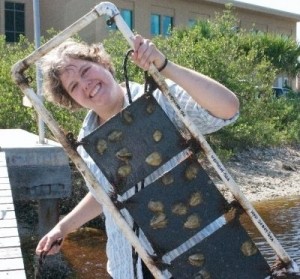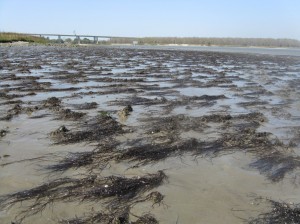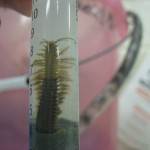Meet ZEN student fellow, Nicole
by Nicole Kollars (ZEN exchange student fellow, Northern Japan site)
My name is Nicole and I am a Master’s student working with Dr. Erik Sotka at the College of Charleston in Charleston, South Carolina (USA). Erik first introduced me to the ZEN project at the North Carolina site earlier this summer and I am looking forward to continuing my experience with ZEN as a student fellow in Japan! I heard that the eelgrass there is up to a meter long (that’s over three feet!) and I can’t wait to see what else may be different (or the same) compared to the other ZEN site I’ve worked at, Middle Marsh, in North Carolina.
Growing up on both coasts
My family is from Minnesota and my parents moved back there a few years ago. I learned how to talk while in California, grew up in Washington State, and went to high school in Oklahoma. After graduating with my Bachelor’s in 2007 from Western Washington University, I lived in Florida, New York, and Oregon before landing in South Carolina for graduate school.
More about me...My favorite color is purple. When working at the fast food restaurant chain Wendy’s, I could make a junior bacon cheeseburger in 3.9 seconds. I swam varsity in high school. I took 9 years of piano lessons. I go a little crazy when given a blank canvas and oil pastels. I really don’t like scary movies or raw onions. Give me a head lamp and a midnight-low tide and I won’t stop smiling for a month!
The science of species invasions
I absolutely love science, especially marine critters. As a Master’s student, I am working with Erik and our collaborator, Dr. Jeb Byers at the University of Georgia, studying the ecological roles of the invasive red seaweed Gracilaria vermiculophylla in the mudflats of the southeastern US. My thesis research focuses on two aspects of this invasion: 1) tracking the invasion history of Gracilaria using a global population genetics approach (if anyone sees Gracilaria and is willing to send us samples please let me know!) and 2) investigating the nature of the relationship Gracilaria forms with a decorating tube worm (the polychaete, Diopatra cuprea).
Going to the ‘birthplace’ of an invasive marine algae
I have spent many a days covered head-to-toe in mud getting to know how Gracilaria looks, feels, and “behaves” in South Carolina, but I have no idea about the ins-and-outs of Gracilaria in its native habitat. How is it different, how is it the same? Well, it just so happens that the type locality for Gracilaria is in Akesshi Bay, Hokkaido, Japan! So I not only have the privilege of helping the ZEN partners in Japan but I also have this amazing opportunity to see Gracilaria in its home waters. It is most definitely a young marine ecologist’s dream come true.
It goes without saying that I am really stoked to go to Japan. I am excited not only to take advantage of the opportunity to learn all I can about native Gracilaria, but also to experience a new culture and a new eelgrass bed. I think the most challenging aspect of working in Japan will be the language barrier, but hopefully I will be able to pick up the basics quickly. I have a Japanese friend here in Charleston who is doing what she can to teach me the essentials. I’ll be boarding the plane to Japan with open expectations but I do hope to come back to Charleston with a new perspective on science and life. I’m looking forward to keeping everyone updated with what I learn, see, and experience as I explore the seagrasses and seaweeds of Japan.
Next time you hear from me, I’ll be in the land of Nihon!






Comments are closed.